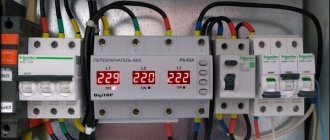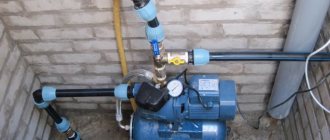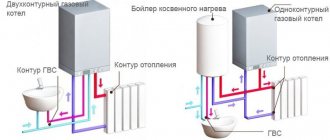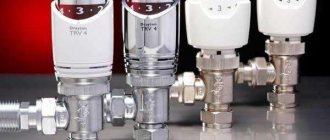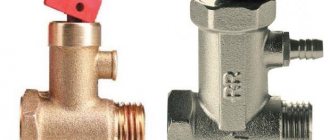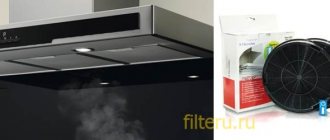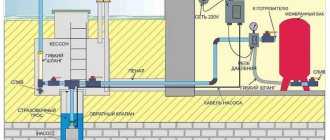26.06.2020
For apartment owners, ventilation is one of the components of a comfortable stay. If there are no ventilation problems in the house, the air will be fresh and clean. To do this, you need to supply air flow from the street while simultaneously removing exhaust air outside.
Types of ventilation according to purpose and method of air exchange
Ventilation systems are divided:
- by purpose - for exhaust and supply;
- according to the method of air movement - forced and natural (passive).
Supply systems supply fresh air into the room, exhaust systems remove waste (contaminated with foreign odors and carbon dioxide) air masses.
Natural ventilation provides air exchange due to the difference in pressure inside and outside the room. This is how a simple window works with normal ventilation. In forced ventilation systems, fans are used for this purpose.
Step-by-step action plan
To carry out all the work yourself, you need to have a minimum of technical skills and know the sequence of such work.
Preparation
Information plus calculations are the basis for preparing the installation of ventilation systems:
- Calculation of the air exchange rate in the house for each room.
- Drawing (diagram) of the movement of air masses. Approximate location of the vent. channels.
- Air duct diagrams are drawn taking into account the design of the room, trying to provide the possibility of hiding air ducts under suspended ceilings, bulkheads, etc.
Detailing
After the scheme has taken on a harmonious appearance and all the design nuances have been taken into account, they begin a detailed plan, drawing up an estimate, incl. choosing an equipment manufacturer:
- The cross-section of the air ducts is calculated and taken into account so that the movement of air is silent.
- Entering parameters into the diagram.
- Drawing up a list of necessary elements.
- The resistance of each section is calculated, fans are selected, and the noise level produced by them is taken into account.
- The cost of all ventilation components is calculated. systems.
In conclusion, a final, clean version with full detail is drawn up. We must not forget about the units for passage of channels through ceilings/walls, consumables (insulating materials, ventilation grilles, fasteners, diffusers, etc.). In the end, all the “little things” add up to a very significant amount of costs, but they are also necessary.
Materials and tools
You will definitely need:
- Hammer.
- Pipes of various configurations, diameters, textures and lengths.
- Connecting elements.
- Adapters, elbows, tees.
- Ventilation grilles moves.
- Holders, hanging elements.
Installation and configuration
Procedure:
- Markings are made on the walls to indicate where the vents will go. channels.
- A diagram of the air ducts is drawn along the ceiling.
- If the system is forced, note where the equipment will be mounted.
- The channels are assembled and mounted on hangers.
- Connect the pipes to a single vent. installation.
- Cover the holes with gratings.
- The equipment is connected to electricity and the entire installation is tested.
Video: ventilation in a private house
What are the reasons for poor ventilation?
In accordance with building codes and regulations, a natural ventilation system is installed in apartment buildings. As a rule, hoods are located in the kitchen and bathrooms. It works as follows: fresh air enters the house through micro-slits in the windows, gaps between slabs, and hoods in the kitchen and bathroom ensure the removal of waste air masses.
Unfortunately, problems quite often arise with the operation of this system. This applies to both residents of houses from the old housing stock and those who live in new buildings. It's no secret that buying a new home does not mean there are no problems with utility networks.
There are several reasons why apartment ventilation stops working normally:
- Air duct contamination . Over time, ventilation ducts become covered with dirt and dust. The lumen of the channels decreases, the efficiency of the hood decreases;
- Icing of the exhaust pipe . In winter, due to insufficient heating and the absence of a low pressure area, the central duct of the hood freezes. Ice buildup impedes air flow.
But the main reason why, in most cases, ventilation performance deteriorates is the massive installation of plastic windows by apartment owners. In most houses built in the last century, the design does not provide for a supply system. In such buildings, the flow of air from the street into the premises is ensured through micro-slits in the wooden window frames. Replacing wooden structures with “plastic” leads to “sealing” of the apartment. This violates the principle of natural supply ventilation: exhaust air leaves, but fresh air does not enter.
Heating the veranda
An open veranda in autumn can be heated with gas heaters, the characteristics and operating principles of which we presented in this article. But if the room is closed, then you will need heating devices that do not emit toxic substances in the form of combustion products.
To decide on choosing a heating device for the veranda, we recommend reading this material, from which you can learn about useful heating devices not only for the dacha, but even for the home!
By insulating the room and installing a small oil radiator or infrared heating here, you will forget that it is raining or snowing, wind or frost outside... it will always be warm inside, which is very important!
Will frequent ventilation help?
Will help. But there is one catch - in order for the air in the room to meet sanitary and hygienic standards, you need to ventilate it every 2 hours. In reality, no one ventilates their apartments so often - at best, 3-4 times a day. There are a number of factors that prevent you from doing this more often:
- Noise. Even if you live far from busy highways, noisy companies or a children’s playground nearby will provide you with a dense background noise;
- Dirt, dust and cigarette smoke. Three reasons why residents of apartment buildings try to open windows less often;
- Drafts. One of the causes of colds, “lumbago” and exacerbation of joint diseases;
- City smog. If the house is located next to a highway or an industrial enterprise, then few people will want to breathe exhaust and factory smoke.
Arrangement of the veranda
Each owner’s winter veranda will be different from others, and this is a fact. Someone will make a small closed room out of this extension where food will be stored in winter, someone will equip it with a simple smoking room and a place for morning coffee while you “wake up” in the morning, but many will bring the veranda to life by installing furniture and appliances here , heaters, armchairs or even a sofa for sleeping, because this is very real. This is exactly what we want to talk about in more detail, about what needs to be done in the veranda to make it cozy and comfortable.
Is air conditioning the solution?
Can air conditioning be the solution to ventilation problems? To answer this question, you need to clearly understand how air conditioning differs from ventilation.
Air conditioning is the maintenance of certain indoor air characteristics. These primarily include temperature (as a rule, this is the only function of entry-level climate control equipment). These parameters also include the level of ionization. In this case, the air conditioner does not provide fresh air. Simply put, it works with the air that is already in the apartment. And for ventilation you will still have to open the windows.
Ventilation is controlled air exchange. Influx of fresh air and removal of “old” air.
What's the result? An air conditioner cannot replace a ventilation system. It only maintains the specified air parameters without changing its composition (proportions of carbon dioxide and oxygen). For complete air exchange, supply and exhaust ventilation is needed.
Winter veranda: equipment and arrangement
Not long ago we were talking about how to insulate a gazebo and prepare it for winter.
But this is not the only option, because at the dacha you can also convert the veranda. And so, today on the agenda is a winter veranda, its equipment and maximum increase in comfort. Not everyone at their dacha has a gazebo, or, in principle, a veranda, but since we talked about a winter gazebo, which you can move into during cold weather, we think that you should think about a veranda. We will not describe again the process of constructing a veranda, about which there is already an article on the DachaDecor.ru website, and we will not talk about insulation. And we will spend time describing how to put the veranda in order and make it truly winter. After all, this is where you can now drink morning tea, have lunch during the day, talk before bed, or even get together on the weekend over barbecue and strong drinks. So, a turnkey winter veranda, or the most comfortable configuration of this room, which, after our recommendations, you can completely transform.
How to understand that ventilation is not doing its job?
There are several signs that may indicate poor performance of the ventilation system:
- “kitchen” and “toilet” odors persist for a long time after cooking;
- there is a high level of humidity in the room;
- stuffiness, stuffiness of air;
- Wallpaper may peel off on the walls and mold may appear;
- fogging of windows.
The lack of normal air exchange has the most negative impact on human health. Poor thermoregulation, combined with excess moisture and respiratory products, contributes to a decrease in immunity, leading to headaches, poor health, and exacerbation of chronic diseases.
Furniture for a winter veranda
Surely, in this room there is already something from the summer veranda - a table, chairs, an ottoman, cabinets.
All this is good, but you can add a little to the package, since for convenience you need a little more than we indicated.
We recommend installing on the veranda a good table for eating, a small table for cooking and cutting food, several chairs or benches near the table, as well as pieces of upholstered furniture.
A sofa and several armchairs for lovers of conversations until late, when you can wrap yourself in a blanket and chat until midnight, several shelves for dishes, a cabinet for a bar or a coffee set - all this will be very useful here.
What type of ventilation should I choose?
If the general house exhaust system works normally, then the task is simplified - in this case it is enough to ensure a constant flow of fresh air into the apartment. You can choose compact ventilation from a large number of systems to suit any budget.
Air infiltration valve (AIV)
The simplest and most affordable option is a supply valve. It is a hollow tube with a filter inside. Installed in a channel that is drilled into the outer wall. During its installation, thermal insulation is provided; on the street side, the ventilation hole is protected by a grille.
Such a compact device (passive ventilator) is devoid of any moving parts and provides air flow due to the difference in pressure in the room and outside. As a rule, it is installed under the heating radiator, which partially prevents heat loss during the cold season. Thanks to the filter (class G3, G4), air is supplied to the room, albeit a little, but free of dust.
The advantages of such a ventilator are its low price, operation without electricity, and ease of replacement. It also has disadvantages - low efficiency in summer (insufficient traction due to a decrease in pressure difference), low purification and drafts and icing in winter.
Breezer
The next “stage of evolution” of supply systems is breathers, a mechanical ventilation device. Unlike valves, they provide controlled active air flow from the street, as well as good filtration and heating of the air. To install them, you also need to make a through hole in the external wall. The design of the breather includes the following elements: an electric fan, a heater, a filter unit (may include a dust, HEPA and odor filter). Modern models of breathers are equipped with an electronic control unit and remote control.
Breezers represent a qualitatively different level of supply ventilation: with such equipment, your home will have clean, warm, fresh air and optimal humidity all year round.
Supply and exhaust ventilator with heat recovery function
Purchasing a device with a recuperator is recommended if the hood in your apartment does not cope with its task. Unlike other “active” ventilators, this supply unit is equipped with a reversible fan - it can provide both an influx of air masses from the street and the removal of exhaust gases from the room.
This device does not have a heater, due to which it consumes less electricity to heat the air in winter than a conventional breather. The device removes warm air masses from the room, which, passing through the heat exchanger, transfer thermal energy to it. Then cold street air passes through the recuperator, heats up and enters the room a little warm, not icy. It's similar to the effect of breathing through a scarf in the cold.
Supply systems: key advantages
What do the listed devices have in common? They have several main advantages:
- ventilation of the room with the windows closed (no noise, dust, foreign odors and drafts);
- quiet or completely silent operation;
- cleaning the air from smog, dust particles and dirt;
- healthy and comfortable microclimate in your home.
Depending on the manufacturer and the specific model, the devices may be equipped with filters of different cleaning classes, noise suppressors, carbon dioxide level sensors, a programmable timer, and may also have a control function via an application on a smartphone.
A large selection of devices with different functionality, design and price allows you to choose a device that suits you in all respects.
Warming the veranda
Without any special details (since you can read about high-quality insulation here), but just for the sake of a reminder. The veranda will be warm if you work with high-quality insulation materials. This could be polystyrene foam or mineral wool, foaming joints, eliminating drafts and minimizing cold bridges, which seriously change the temperature. You can familiarize yourself with the material - do-it-yourself winter garden.
Also, if you are turning an ordinary veranda into a winter one, you need to take care of the windows, because they are the ones who will stop the cold from penetrating inside.
You can install new windows, or you can simply repair old ones, which we suggest reading about in a good article about window restoration and creating high-quality double-glazed windows.
How to calculate the optimal air exchange rate?
When making calculations, you need to take into account the number of people living in the apartment. On average, 3 cubic meters of air should flow per square meter of living space per hour. However, the recommended rate of air replacement differs in different rooms. For a bathroom this is 25 cubic meters per hour, for a bathroom - 50 m3, for a kitchen with an electric stove - 60 m3 per hour, for a kitchen with a gas stove - at least 90 m3.
There is also another calculation recommendation: an adult consumes about 30 cubic meters of air per hour, a child about 20 cubic meters.
Equipment installation
The winter veranda is warm and cozy, you can sit in a comfortable chair, drink warm cocoa or have dinner with your family. But in such situations, light music will not hurt. Therefore, you could install a radio or a small music center here. If you like to watch the evening news or your favorite TV series, then a small TV and maybe a DVD player won't hurt. In general, it’s up to you to think about technology, but we recommend not to forget about it, because the complex of work and sleep (without any entertainment) quickly leads to a state of apathy.
Let's sum it up
The main reason for the deterioration of ventilation in apartment buildings is the installation of plastic windows.
Ventilation is a limited solution due to dust, noise, smog and drafts. The air conditioner does not provide air exchange, but only cools the air that is already in the apartment.
If the exhaust ventilation in the apartment does not work, then you should think about installing a full-fledged supply and exhaust system such as a recuperator.
When the hood is working normally, it is recommended to install supply ventilation - a valve or breather.
Veranda repair
You should start with repairs. After the summer, all the materials in the extension were slightly worn out due to frequent visits, changes in humidity and temperature, and therefore the veranda needs to be put in order. Puttying and painting surfaces, replacing some parts, updating walls and preparing them for winter, light cosmetic repairs. Perhaps someone will need a major one, but it had to be thought through in the summer, since in the fall, when it is damp and cool outside, it is not recommended to do a lot of repairs. Wallpaper falls off due to humidity and drafts, putty on the walls does not dry, just like varnish on wood, the smell of paint does not disappear for a long time. Therefore, we are now postponing major repairs to the spring, but first we study the finishing materials in this article!



